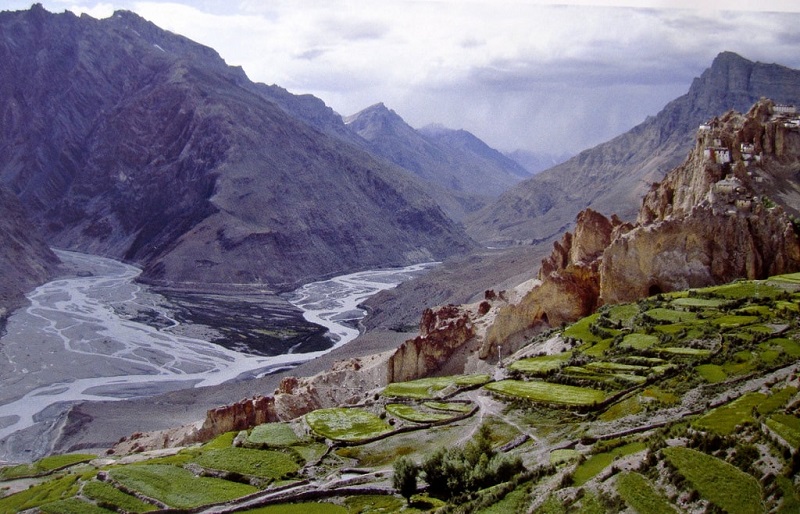Spiti Valley
The Spiti Valley, a gorgeous haven resounding with peace and spirituality, is home to various Buddhist monasteries and breathtaking natural features, the most of which are unknown and hence unspoiled.
The Spiti river, which bursts through steep gorges and valleys and is tucked away in Himachal Pradesh, cuts a sharp swath through the valley’s craggy topography. Those who enjoy water sports, particularly river rafting, are highly fond of the river.
Adventure sport enthusiasts can enjoy camping, paragliding, and walking in the valley’s lush, emerald nature, which is bordered by snow-capped mountains.
About the Destination
For those who set out to float from the visiting routes, Spiti, a less well-known neighbour of Ladakh, is a cold alpine desert. Himachal Pradesh’s powerful, fruitless Himalayas enclose Spiti’s postcard-perfect towns. Here you can climb alongside Snow Leopard and Himalayan Wolf habitats.
You can visit religious communities that date back more than a thousand years. Experience an intriguing society and cuisine that differ from what’s left of India. Meet the kindest people who lead the harshest lives. As Rudyard Kipling famously said, this is a world within a world.
Climate
The amount of snowfall has allegedly decreased and glaciers have been melting more quickly, according to residents of Spiti, particularly those in higher-lying settlements like Komik, Kibber, Lhangza, etc. The only source of water for Spiti’s villages is snowmelt from the region’s glaciers and winter snows.
Agriculture in the valley, a high-altitude cold desert that already has only one agricultural season due to glaciers that are melting more quickly and with less snowfall. The custom of Gaddi shepherds travelling annually with their herds of sheep and goats to Spiti is in jeopardy due to climate change.
It is causing the pastures to decline in quality, and the ice bridges that Gaddis and their flocks could formerly use to cross rivers and avoid villages are now disappearing. Ground-level observations of climate change are supported by scientific investigations.
How to Reach
Two street routes connect Shimla and Manali to the Trans-Himalayan region of Spiti; one travels through the Kinnaur valley. The former requires at least two days, including a stopover at Kalpa or Reckong Peo, and although longer, provides more time to gradually acclimate to the altitude. The last one takes 12–14 hours, depending on the state of the roads.
Things one should Pack
The weather in Spiti is so bizarre for a cold alpine desert that it almost makes no sense! The sun’s rays are harsh enough to burn your flesh, but shaded areas are cool enough to wear clothing. Layering your clothing is recommended, and you should also bring long-sleeved t-shirts, sun hats, sunglasses, and whatever other sun protection you can find. Unquestionably necessary are comfortable walking shoes.
Culture
Tibetan Buddhism is practised by the natives of Spiti, and the region’s culture is comparable to that of its adjacent locales, including Tibet, Ladakh, and the Hangrang valley of Kinnaur. The Spiti valley is home to representatives of the Sakya, Nyingma, and Gelug schools of Tibetan Buddhism. Monasteries are located in Spiti for each of these schools.
Homestays
With the help of Ecosphere, a nonprofit organisation aiming to progress the community practically, some Spitian families have welcomed travellers into their homes and hearts in the higher, more remote settlements. Although simple, Spitian residences are big and spacious, and they have the captivating Himalayas as a backdrop! The bathrooms in Spitia are dry and de-treating the soil in nature; you have to squat over a hole in the ground and throw feed through it after you’re done. Compost is made from it and it decomposes regularly.
Cost to visit spiti
If you visit the Spiti Valley, you can choose from a variety of lodging alternatives based on your level of comfort, taste, season, and other factors like the weather and road conditions. Any isolated and tribal area in Himachal Pradesh or anywhere in the Himalayas would attest to this.
A variety of lodging choices are available, ranging from a one-night stay at a dhabha tent or shack for $100. To a stay at a low-cost guest house or a homestay in Spiti for $250 to $400 to a stay at a medium-priced hotel. Or guest house for $700 to $1,500 to a stay at a hotel that costs $3,000 or more. It provides significantly more comfort, convenience, food, etc.
Food
It falls under a similar category. Pizza, dal, rice, roti, dal fry, maggie, vegetarian or non-vegetarian meals, etc. are all options. In regards to food, however, where you choose to eat and drink is more essential.
Thus, it is difficult to determine the price or budget for any vacation, including a trip to Spiti Valley, because there are so many factors based on personal perspective and preferences.









